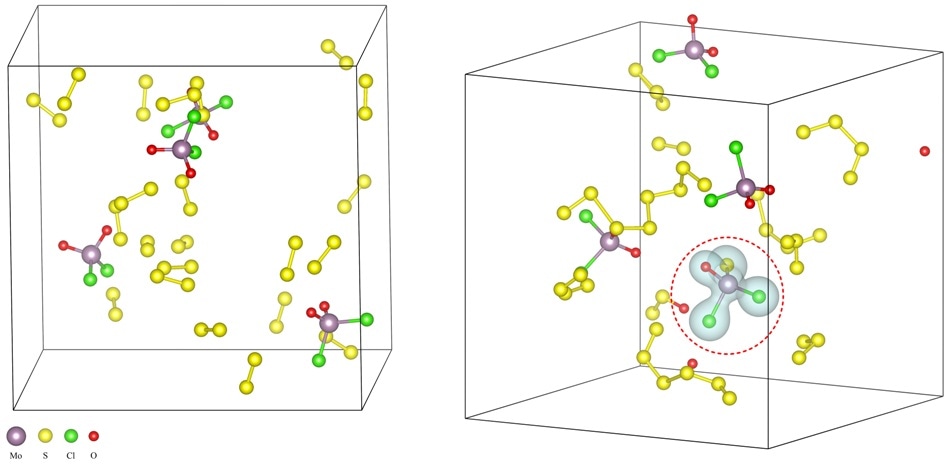Apr 20 2018
A pinch of salt can make simpler the creation of two-dimensional (2D) materials, and due to the efforts of researchers at Rice University, the reason is becoming evident.
 Rice University scientists built computer models of intermediate reactions to understand why salt lowers reaction temperatures in the synthesis of two-dimensional compounds. Above left, molybdenum oxychloride precursor molecules undergo sulfurization in which sulfur atoms replace oxygen atoms. That sets up the material to form new compounds. At right, the calculations show the charge densities of the new molecules. (Image credit: Yakobson Group)
Rice University scientists built computer models of intermediate reactions to understand why salt lowers reaction temperatures in the synthesis of two-dimensional compounds. Above left, molybdenum oxychloride precursor molecules undergo sulfurization in which sulfur atoms replace oxygen atoms. That sets up the material to form new compounds. At right, the calculations show the charge densities of the new molecules. (Image credit: Yakobson Group)
Boris Yakobson, a Rice professor of materials science and nanoengineering and of chemistry, was the subject expert when a group of labs in Singapore, Japan, China, and Taiwan used salt to create a “library” of 2D materials that incorporated transition metals and chalcogens.
According to the Rice team, these compounds could pave the way for smaller and faster transistors, sensors, photovoltaics, and catalysts.
Using first-principle molecular dynamics simulations and exact energy computations, Yakobson and his colleagues established that salt decreases the temperature at which certain elements interact in a chemical vapor deposition (CVD) furnace. That makes it easier to form atom-thick layers resembling graphene but with the potential to modify their chemical composition for specific layer-material and consequently electrical, catalytic, optical, and other beneficial properties.
Recently, the research team including Yakobson and Rice postdoctoral researcher Yu Xie and graduate student Jincheng Lei reported the results in Nature.
The team led by Zheng Liu of Nanyang Technological University in Singapore used its seasoned method with CVD to develop 47 compounds of metal chalcogenides (which comprise a chalcogen and an electropositive metal). Most of the new compounds contained two ingredients, but a few were alloys of three, four, and even five. A number of the materials had been imagined and even coveted, Yakobson said, but never created.
In the CVD process, atoms excited by temperatures - in this case between 600 and 850 °C (1,112 and 1,562 °F) - form a gas and eventually settle on a substrate, connecting to atoms of complementary chemistry to develop monolayer crystals.
The team already supposed salt could facilitate the process, Yakobson said. Liu went to him to request a molecular model analysis to study why salt made it easier to melt metals with chalcogens and trigger them to react. That would help them understand if it might work within the wider palette of the periodic table.
They did impressively broad work to make a lot of new materials and to characterize each of them comprehensively. From our theoretical perspective, the novelty in this study is that we now have a better understanding of why adding plain salt lowers the melting point for these metal-oxides and especially reduces the energy barriers of the intermediates on the way to transforming them into chalcogenides.
Boris Yakobson
Whether in the form of common table salt (sodium chloride) or more unusual compounds like potassium iodide, salt was observed to allow chemical reactions by minimizing the energetic barrier that otherwise prevents molecules from interacting at anything below ultrahigh temperatures, Yakobson said.
I call it a ‘salt assault. This is important for synthesis. First, when you try to combine solid particles, no matter how small they are, they still have limited contact with each other. But if you melt them, with salt’s help, you get a lot of contact on the molecular level.
Second, salt reduces the sublimation point, where a solid undergoes a phase transformation to gas. It means more of the material’s component molecules jump into the gas phase. That’s good for general transport and contact issues and helps the reaction overall.
Boris Yakobson
The Rice researchers found out the process doesn’t directly facilitate the creation of the 2D-material itself so much as it allows for the creation of intermediate oxychlorides. These oxychlorides then facilitate the 2D chalcogenide growth.
Yakobson explained that detailing this process would need intensive atom-by-atom simulations. These required weeks of comprehensive computations of the quantum interactions among as few as 100 atoms – all to reveal merely 10 picoseconds of a reaction. “We only did four of the compounds because they were so computationally expensive, and the emerging picture was clear enough,” Yakobson said.
The paper’s co-authors are Jiadong Zhou, Fucai Liu, Qundong Fu, Qingsheng Zeng, Hong Wang, Yu Chen, Juan Xia, Ting Yu and Zexiang Shen of Nanyang Technological University, Singapore; Junhao Lin and Kazu Suenaga of the National Institute of Advanced Industrial Science and Technology, Tsukuba, Japan; Xiangwei Huang, Guangtong Liu, Yao Zhou and Qian Liu of the Chinese Academy of Sciences, Beijing; Huimei Yu of East China University of Science and Technology, Shanghai; Di Wu and Chuang-Han Hsu of the National University of Singapore; Changli Yang and Li Lu of the Chinese Academy of Sciences and Collaborative Innovation Center of Quantum Matter, Beijing; and Hsin Lin of the National University of Singapore and the Institute of Physics, Academia Sinica, Taipei, Taiwan.
The research was supported by the U.S. Department of Energy, Singapore National Research Foundation, JST-ACCEL, JSPS KAKENHI, the National Key Research and Development Program of China, the National Natural Science Foundation of China, the Ministry of Science and Technology of China and the Chinese Academy of Sciences.
MoO2Cl2 formation from MoO3 and NaCl
A molecular dynamics simulation by Rice University scientists shows a layer of salt and molybdenum oxide mixing together to form molybdenum oxychloride. The atoms are oxygen (red), sodium (yellow), chlorine (green) and molybdenum (purple). (Video credit: Yakobson Group)